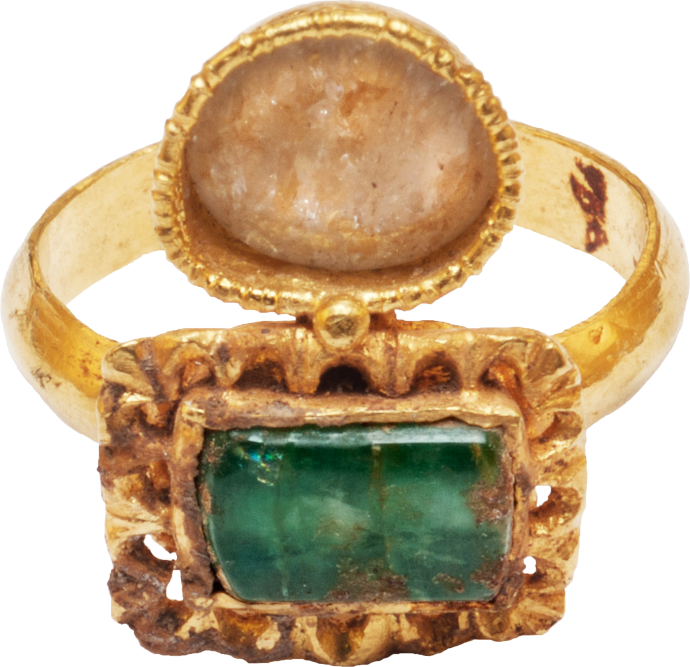


Gold Ring with Double Bezel, Set with Emerald and Rock Crystal
, Roman, 4th century

Gold Ring with Double Bezel, Set with Emerald and Rock Crystal
Description
The hoop is a thin band, convex on the exterior and flat on the inside. The terminals join a rectangular box-bezel set with a polished, slightly convex emerald, which has been drilled through. Three gold pellets decorate the join with the hoop on either side. An openwork (opus interrasile) frame of arches borders the bezel. Attached to the side of the bezel by means of a cylindrical bead is a round, cup-shaped element set with a rock crystal bordered along the rim with thin beaded wire. A single pellet marks the join.
No similar ring is recorded, but the individual elements, notably the box-bezel with openwork frame, are characteristic of jewelry of the late third and fourth centuries. Although cell work with opus interrasile is commonly found in the third century, the closest examples to that of the ring are found on bracelets of the fourth century, notably an example in the Römisch-Germanisches Museum in Cologne (fig. 8.1). The use of a small second bezel added to the side of the primary bezel is a fashion that appears to have originated in the fourth century and remained popular, both in Byzantium and the West well into the sixth century in ever more elaborate forms. A particularly fine early example in the Museum für Angewandte Kunst in Cologne has a solid-cast hoop with floral decoration, a diamondshaped central bezel set with a garnet, and a side bezel set with an emerald.
Other examples include a ring with embossed gold work set with emerald and garnet in the Koch Collection. Byzantine rings of c. 500 continued to develop the shape, with a stepped rectangular bezel set with a variety of precious gems and a side bezel in the form of an attached cone, usually set with a pearl (cat. nos. 12 and 13). Merovingian examples are also known. The present ring is one of the earliest known examples, and its technique suggests that it derives from a workshop that produced other types of important jewelry, such as the large openwork bracelets set with gems.
Notes
A fourth-century bracelet ornamented with emeralds with opus interrasile frames was discovered in a grave in Cologne (now Römisch-Germanisches Museum, inv. 1498); see Yeroulanou 1999, p. 241, no. 205 and fig. 148. For the ring in the Museum für Angewandte Kunst in Cologne, Chadour and Joppien 1985, p. 104, no. 154 (probably of fifth-century date). For examples in the Koch Collection, Chadour 1994, p. 124, no. 426 (with embossed bezel set with garnet and emerald); and p. 144, no. 484 (set with garnet and pearl). Another early example, set with an emerald and a pierced sapphire, is in the British Museum, Marshall 1907, p. 133, no. 815; and Johns 1996, p. 57, fig. 3.17.